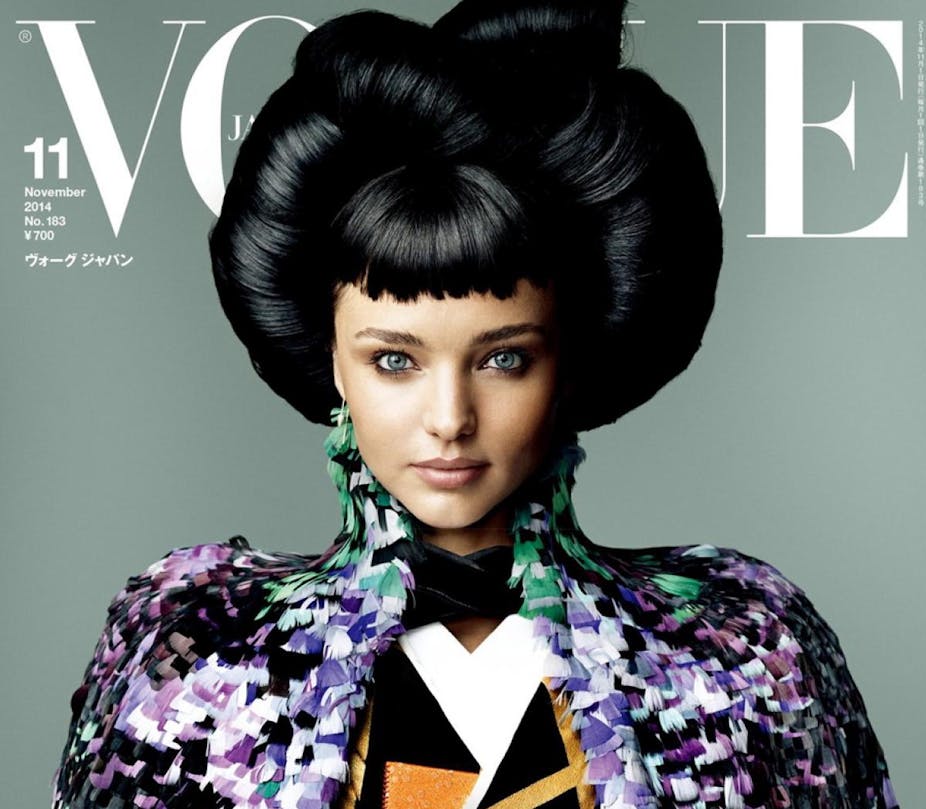Miranda Kerr sparked controversy last week when she appeared in Japanese Vogue dressed in a kimono. Critics in the blogosphere and The New York Daily News wondered whether her donning traditional Japanese dress was “cultural appropriation”.
This is a term that has gained some press in the past two years through discussions of No Doubt’s use of Native American headdresses in their video for Looking Hot, Iggy Azalea’s adoption of African-American style and Miley Cyrus’s apparent “borrowing” from “ratchet” culture.
Cultural appropriation refers to a practice where white people “borrow” from a non-white culture. From burning incense to wearing a keffiyeh scarf to sending texts using “rap” language – these are all acts of poaching from another (i.e. non-white) culture.
It is about “dressing up”. But it is also about a pretty uneven power relation between the one doing the taking and the culture from which they take.

Kerr no doubt looks striking in “Oriental” garb. But critiques of the choice by Anna Dello Russo to style her as such speak to the broader issue of whether it is okay for white people take from non-white cultures.
Part of the issue is the privilege of play. That is, the invisible “white privilege” white people possess means they can “play” at being a non-white person without the burden of discrimination non-white people experience.
This has been the subject of a sustained campaign on US college campuses in recent years. When it gets tough white people can simply slough off their non-white accoutrements. The bodily markers of difference non-white people possess means they do not have the same privilege.
Cultural appropriation is also problematic because it reduces whole countries and populations to a few “exotic” objects. Sometimes – such as the case with Native American headdresses – these objects are sacred and the reduction of them to fashion accessories evacuates that sacredness.
A headdress becomes equivalent to a fedora hat to a sarong to an obi and so on. It is like a cultural colonialism. The intrepid white fashion explorer “discovers” the spoils of the Orient, brings them home and sells them on to other white people.
Also at work here is the type of hipness one can gain from non-white cultural accessories. Iggy Azalea and Miley attempt to prove (to varying degrees of success) their hip-hop chops by performing African-American culture.
But the form Kerr’s cultural appropriation takes is perhaps more insidious. As a model, she demonstrates the superficial mode, which much cultural appropriation takes. While Iggy and (maybe) Miley appear committed to their “style”, however problematic, Kerr is dressed as a geisha on Vogue’s cover, a samurai in its pages and will no doubt appear in other “exotic” outfits in shoots to come.
The ease with which she “transforms” demonstrates the privilege of play. But the praise and press the shoot has garnered also associates her appearance in Vogue Japan with sophistication and coolness. Fashion Rogue blog writes that Kerr is “elegant,” Styleite calls it “tasteful”. In this case, non-white cultural objects work as accessories used to shore up the white model’s sophistication.
The Kerr case, to me, is further complicated by the specific position of Japan in Western imaginations.

It would be remiss, and perhaps just as problematic, to lump all non-white cultures together in a similar manner to the way a cultural appropriator does a headdress and a fedora. Japan has, for decades, functioned as a signifier of “cool” to westerners (though Korea is perhaps now more favoured).
Unlike headdresses and saris, which bestow an “authenticity” based on the past to the appropriators, Japanese cultural objects are generally positioned as futuristic (such as robots) or traditional, yet timelessly stylish (such as sushi, Japanese interior design).
Though the kimono is traditional, its function on the cover of Vogue Japan is as a signifier of timelessness. Vogue being the archetypal arbiter of Western sophistication, its cultural significance is understated, tasteful style.
Kerr’s styling is not intended to mimic “real” Japanese kimono aesthetics. Rather, it works to associate Japanese traditional style with the timeless image of Vogue. It’s a more nuanced form of cultural appropriation than, say, Avril Lavigne’s ham-fisted poaching of kawaii (cute) culture in her recent video Hello Kitty.
Lavigne’s foray into Japanese cultural forms reiterated stereotypes of the cute – but silent – Asian woman. The “Harajuku girls” in her clip functioned similarly to the African-American back up dancers for Miley at the VMAs in 2013 – they were props.
While Kerr’s appearance in Japanese clothing is problematic, it is also more complicated than the standard cultural appropriation as contemporary colonialism model. It is also important to consider the audience for Vogue Japan. It is a primarily Japanese audience.
The politics of her “dressing up” might be different had she been on the cover of Vogue or Elle US in non-Western garb (just as Pharrell has been).
A final complication is Japan’s stereotyped position as expert poachers of Western cultural practices and styles.
Further, as media and cultural scholar Koichi Iwabuchi argues, Japan functions as a “transformer”, which “Asianises” Western forms for a pan-Asian market. The kimono has recently experienced a revival in Western fashions – it was the hot item for this year’s summer festival circuit in the US.
By re-appropriating the kimono, Japanese Vogue in some ways speaks back to such cultural appropriation. It restyles and reclaims the traditional garb and sells it back, not only to a Japanese audience, but to a global fashion public.

